Continuing my series of posts of my pictures from 1978 which will eventually include all of the selected photographs I took in London in 1978 and posted recently on Facebook with comments, and a few related images. All of these pictures (and more) are in my London Pictures web site, and eventually I intend to add the comments there too.
Click on any image to go to the web page – with a slightly larger picture for landscape format images.
__________________________________________
London 1978 (10)
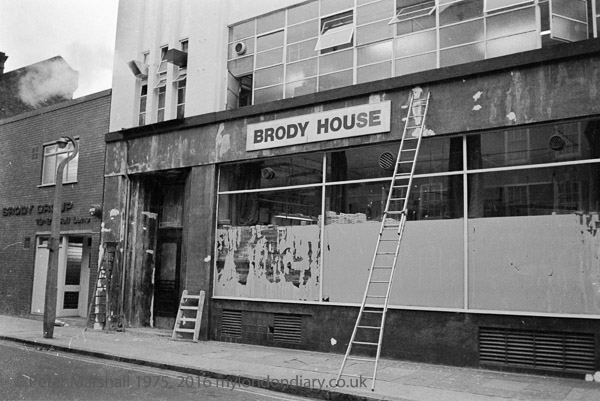
Brody House, Bell Lane, Spitalfields, 1978
17g61: offices, shop, Tower Hamlets
Brody House, built in 1938 is a fairly rare example of surviving 1930s architecture in the area. This view is of the back of the large development, which has its front in Strype St.
Estate Agents now describe this as “one of Spitalfields most sought-after residential blocks” and a 2 bedroom flat will set you back around £700,000. Built as a button and sequin factory for the Brody company, it was considerably smartened and extended as luxury flats, complete with concierge in 1998.
The building at left has been replaced by an extension which looks authentically from the 1930s up to 2nd floor level. The large ground floor windows have gone and to the left of the main doorway on the ground floor is now Cycle Surgery.
Brody Trims began their family business here in 1938 and is still very much in existence, making high quality British sequins and sequin trimming, embellished trimmings, elasticated trimmings and other haberdashery and craft goods, mainly for the fashion trade, the only company in the whole of Europe that still provides this service. They only got into the sequin business in the 1960s.
Clearly, sequins were still being made when I took this picture, with steam coming out of the building. And perhaps the long ladder suggests that some much-needed work on the surface of the building was about to be attended to. But the ladder attracted me to think of two famous images in photography, very different from this, W H F Talbot’s ‘The Ladder‘ at Lacock Abbey, though sadly for this picture there were no manservants I could pose around it, and his ‘The Haystack‘.
Not far from here also in Bell Lane Tracey Emin wanted to knock down a listed 1927 social housing block built by Stepney Borough Council to extend her studio, but planning permission was refused in 2016 and she decided to move to Kent. She had bought the block for over £3m, with planning permission to develop it but which required keeping the two street facades.

Whitechapel, 1978
17g66: shop, Tower Hamlets
Whitechapel was then full of small, mainly wholesale, clothing shops such as this one – and quite a few remain. I was attracted both by the odd tableaux in the window and the figures in the doorway, one headless. It was a hot August day and there were two women seated inside, watching me, though I think I had failed to notice the one of them largely hidden by a hanging dress.
This was the second frame I made, the first an immediate response with camera slightly tilted, this more carefully framed, but with a woman at right walking into the picture as I took it.
Taken not long after the picture of Brody House on Bell Lane, this could have been in any of several streets in the area to the north of Whitechapel High St, perhaps Goulston St, Wentworth St or on the High St itself.
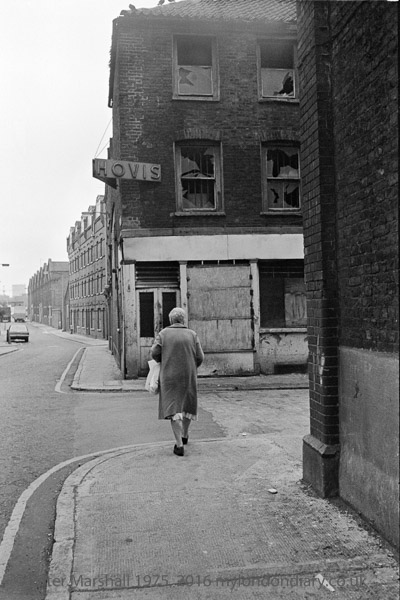
Quaker St, Shoreditch, 1978
17h25: shop, Tower Hamlets
This view is on Quaker St, with the woman about to step onto Sheba street, beyond which you can see the openings of Wilkes St and Grey Eagle St. Beyond that is a long building with 7 bays, which, unlike the rest of this is still standing.
The bakers on the corner with its HOVIS sign was clearly closed and derelict and this whole area due for demolition.
Quaker St (originally called Westbury St) is crossed by Wheeler Street, and one of the earliest Quaker Meeting Houses was here in the 17th century. The building which replaced it, Bedford House, is now Grade II listed.
The only building in the picture still partly standing is that distant long building, Silwex House at 1-9 Quaker Street. It was built in 1888 as stables for the Great Eastern Railway and has a similar long brick appearance with 7 gables at the rear facing the railway line out of Liverpool St, where the Braithwaite viaduct, build 1839-42 is a listed building. Silwex house later became a part of the nearby Truman Brewery. Planning permission was granted to convert it into a 250 room hotel, which included a 3 storey roof extension, with the original front and back walls being retained.
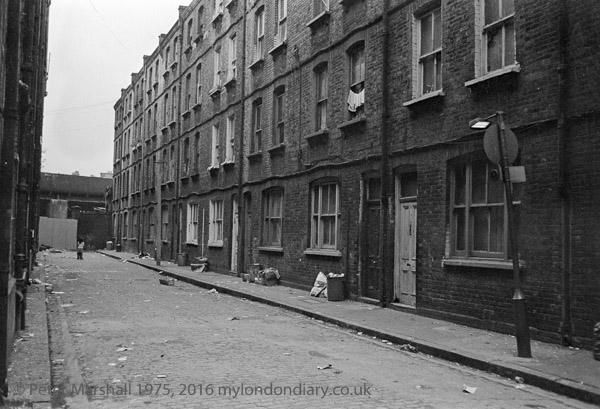
Shoreditch, 1978
17h32: housing, Tower Hamlets
Taken somewhere near Brick Lane, this is a short stretch of road ending at the railway line into Liverpool St. It no longer exists but I am fairly sure that this was the section of Grey Eagle St to the north of Quaker St, where there is now a gate leading to Eagle Works. The buildings on both sides of the street have now gone.
It was a pity that my black and white pictures did not include the two buildings on the corners of Quaker St and Grey Eagle St, the Grey Eagle Pub and Leons, though I think I photographed one or both in colour. But in 1978 I was still working on colour transparency and never managed to develop a reliable filing system.
As well as Grey Eagle St there is also a Black Eagle St (now Dray Walk) not far away. At the end of the 16th century the area belonged to a goldsmith, Richard Hanbury, who leased part to brickmaker Edward Hemmynge, perhaps the source of Brick Lane, though there were other later brickworks in the area. Quaker St was laid out around 1656 by William Browne who had leased three acres of pasture. Hanbury’s daughter married Sir Richard Wheler (hence Wheler St) whose family retained much of the area, leasing parts out. Both Grey Eagle St and Black Eagle St were developed by one of the lessees, John Stott, a mariner from Stepney around 1661-70, and in 1666 the Black Eagle Brewery was built, possibly by London entrepreneur William Bucknall on land leased from Stott. Some sources say the Brewery name came from the strret name, but its origin is unclear.
Around 1679 the brewery with its eagle trademark was acquired by Joseph Truman who had learnt the trade there (though the family records say a family member, William Truman, a brewer, attacked the Lord Mayor of London during Wat Tylers 1381 revolt) and slowly began to grow into a huge concern. Under one of his younger sons, Benjamin Truman, it became the third biggest brewery in London. In 1789 the young Quaker businessman Sampson Hanbury purchased a share in the brewery and gradually bought more, taking over the running of what with the company becoming Truman and Hanbury. Some years after Hanbury’s nephew Thomas Fowell Buxton became a partner the company became Truman, Hanbury, Buxton and Company. Buxton was a partner with William Wilberforce in the Anti-Slavery Society founded in 1823.
Another brewer, Thomas Pryor joined the company in 1816, and the business was run by the three brewing families, Hanbury, Buxton and Pryor until the 1950s, becoming the largest brewery in London, outproducing Barclay Perkins, around 1850. The company was the subject of a bitter takeover battle between Watney’s and Grand Met in 1971. Grand Met won and the following year rubbed salt into the wound by taking over Watney’s. In 1989 Grand Met, who had failed to keep up with the changes in beer consumption towards real ales, realised that the London property boom made the site more valuable than a not too profitable brewery and closed it. But the property bubble burst, and in 1995 the 10 acre site was sold to the Zeloof partnership, who reopened Black Eagle St as Dray Walk and The Old Truman Brewery as a venue for events of various kinds.
[Thanks To Martyn Cornell’s Zythophile beer blog for much of the brewery information in a highly detailed article about the Truman Black Eagle Brewery.]
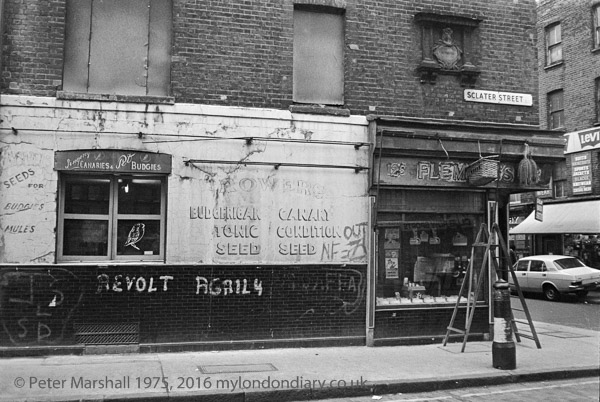
Sclater St, Spitalfields, 1978
17h36: shop, Tower Hamlets
The street name clearly shows where this was taken, on the corner where Sclater St meets Brick Lane. The plaque on the wall above and to the left of the modern street sign states “This is Sclater St 1798”.
Sclater Street had long been famous for having a bird market every Sunday, but during the rest of the week there were just a few shops, such as this, still operating. Trowers with its ‘Singing Canaries & Pet Budgies’ had a different name on the shop front, part obscured by a basket. It is now a shop selling women’s fashion.
It wasn’t just birds that were sold here, at least in earlier days, but a wide range of wild animals. The whole area – which crossed over the Bethnal Green Road into a street called Club Row – was known as Club Row Market and back in the 1950s you could buy puppies, cats, snakes, gerbils, monkeys and more – even the occasional lion cub. Pressure by animals rights groups and bodies such as the RSPCA eventually led to the end of live animal sales, finally banned on the streets by Tower Hamlets Council in 1983.
The house has been done up a bit since, the signage removed and a new door added with the window shuttered, while the first floor now has windows and curtains and appears occupied, and, like most surfaces around Brick Lane is now covered with graffiti. Back then there was relatively little graffiti, and the word ‘REVOLT’ really stood out, though the second word, which appears to be AGAIL4 is incomprehensible to me. Further to the right is a reminder that this area was close to Bethnal Green Road where the National Front used to come to sell their racist news sheets – and were sometimes involved in scuffles with anti-racists.
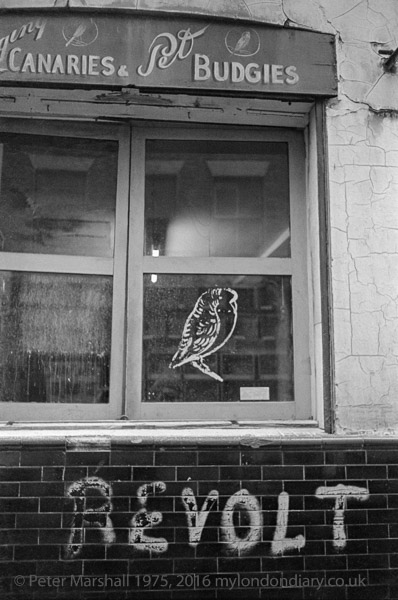
Sclater St, Spitalfields, 1978
17h42: shop, Tower Hamlets
A closer view of a part of the wall, apparently inciting Canaries and Pet Budgies to revolt.
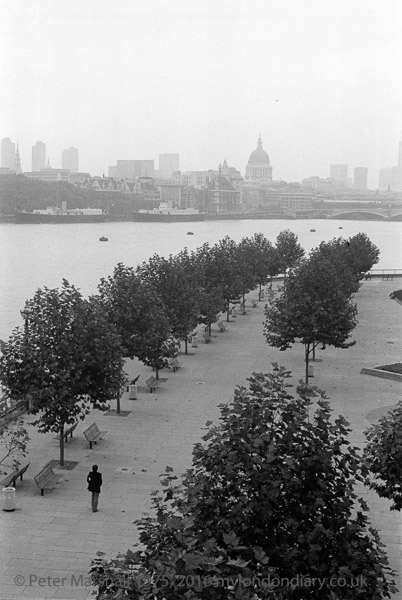
Albert Embankment, River Thames and St Paul’s Cathedral, 1978
17y32: Southwark, City, river, trees
A surprisingly grainy view of a man, the only man on the Albert Embankment, contemplating the view on a slightly foggy day in London town.
Through the November haze is the London skyline with St Paul’s Cathedral. The trees are now noticeably larger, but this section of the skyline is still remarkably similar, with the Barbican towers at left and just one new tall building until close to the right hand edge where a number of new tall blocks have been built.
More to follow….
______________________________________________________
There are no adverts on this site and it receives no
sponsorship, and I like to keep it that way. But it does take a considerable amount of my time and thought, and if you enjoy reading it, a small donation – perhaps the cost of a beer – would be appreciated.
My London Diary : London Photos : Hull : River Lea/Lee Valley : London’s Industrial Heritage
All photographs on this and my other sites, unless otherwise stated, are taken by and copyright of Peter Marshall, and are available for reproduction or can be bought as prints.
To order prints or reproduce images
________________________________________________________
London 1978 (10)
Continuing my series of posts of some of my pictures of London from 1977 re-posted with the comments I made on Facehook. All pictures (and more) are on my London Photos web site.